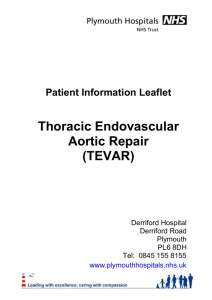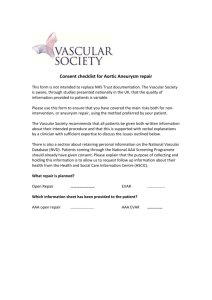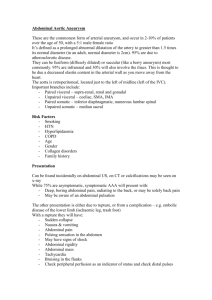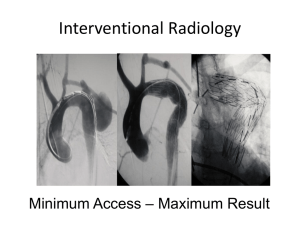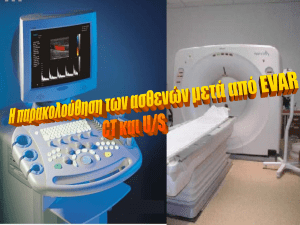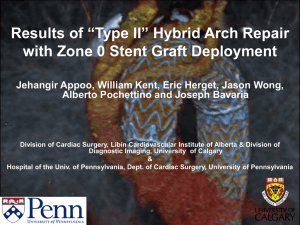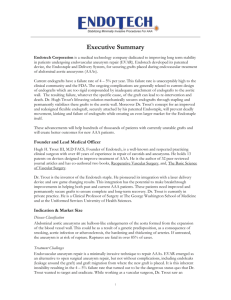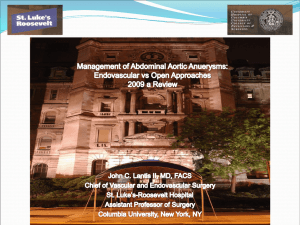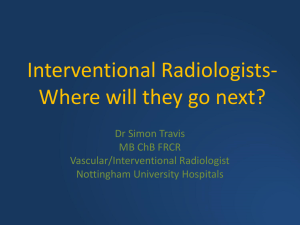Endovascular Aortic Repair (EVAR)
advertisement
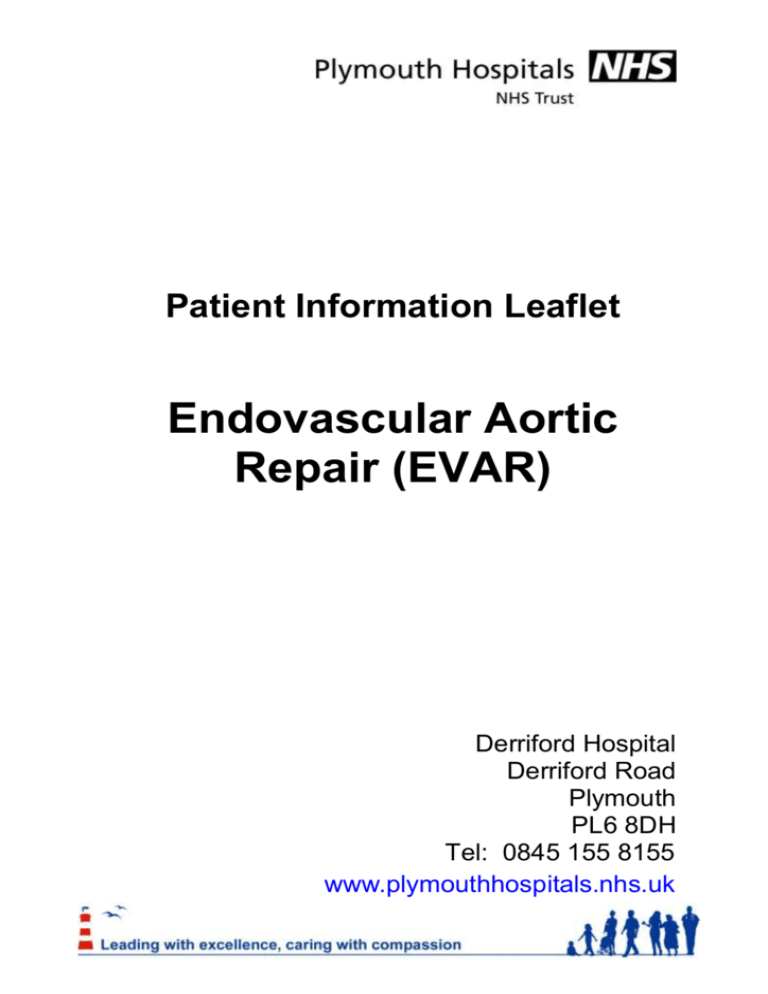
Patient Information Leaflet Endovascular Aortic Repair (EVAR) Derriford Hospital Derriford Road Plymouth PL6 8DH Tel: 0845 155 8155 www.plymouthhospitals.nhs.uk This leaflet tells you about having an endovascular aortic repair (EVAR). It explains what is involved and what the possible risks are. It is not meant to replace informed discussion between you and your doctor, but can act as a starting point for such discussions. If you have any questions about the procedure please ask the doctor who has referred you or the department which is going to perform it. Referral and consent The referring clinician should have discussed the reasons for this examination with you in the clinic and you should make sure that you understand these before attending. Before the procedure you will need to sign a consent form. This form says that you need to know what risks are involved. This is a legal requirement and ensures that you are fully informed about your procedure. If after discussion with your hospital doctor or radiologist (a doctor who has trained and specialised in imaging and x-ray treatments) you do not want this examination then you can decide against it. At all times the radiologist and referring clinician will be acting in your best interests. What is an EVAR? Endovascular aortic repair (EVAR) is a way of repairing an abnormality in the main blood vessel leaving your heart (aorta) by inserting covered metal mesh tubes (stent grafts). Stent grafts are typically inserted in a minimally invasive manner via the arteries in your groin using X-ray guidance to position them accurately. It is an alternative procedure to the conventional open surgical repair of the abdominal aorta. Why do you need an EVAR? You will have already had imaging, either a computed tomography (CT) or a magnetic resonance imaging (MRI) scan, to look at the aorta in your abdomen. The tests have shown that the aorta in your abdomen is enlarged and has developed an aneurysm. The size of the aneurysm is such that there is a risk of it bursting (rupture). This is a very serious problem and most people will not survive a rupture. Repairing the aorta before it ruptures usually has good results. Repair can either be done with a major surgical operation to replace the abdominal aorta with a ‘plastic tube’ or the aorta can be ‘relined’ from the inside with a stent graft. Both procedures work well, with EVAR being a less significant procedure. Not all patients with an aneurysm are suitable for EVAR, but imaging has shown that yours is. Are there any risks? EVAR is a major but normally safe procedure. There are a number of risks and complications that can arise. They are relatively rare; some are less than a major surgery, others are about the same. There can be damage to the blood vessels through which the tubes are placed or damage to the aneurysm causing a leak. This may require other radiological procedures or conversion to a major surgical repair. Occasionally, because of the size of your blood vessels, it may not possible to insert the stent graft satisfactory and surgical conversion may also be required. These complications are uncommon. The stent graft may not completely seal the aneurysm, allowing it to continue to fill. Small leaks are quite common and usually require no additional treatment. Some larger leaks may require a further procedure to seal them. There are small risks related to the anaesthetic which will be explained to you by your anaesthetist. Are you required to make any special preparations? You need to be an inpatient for the procedure. You may be asked not to eat for four hours before the procedure, although you may still drink clear fluids such as water. If you have any allergies or have previously had a reaction to the dye (contrast agent), you must tell the radiology staff before you have the test. If you are pregnant of suspect that you may be pregnant you should notify the department. Radiation exposure during pregnancy can lead to birth defects. The procedure can be carried out with a variety of anaesthetic techniques ranging from a full general anaesthetic to a needle in your back to numb your lower body (spinal). The anaesthetist will explain the various options and risks. Who will you see? A team of doctors, including a vascular surgeon and a specially trained doctor, called an interventional radiologist, performs the procedure. Interventional radiologists have special expertise in reading the images and using imaging to guide catheters and wires to aid diagnosis and treatment. Where will the procedure take place? In the interventional radiology suite which is located within the radiology department. This is similar to an operating theatre into which specialised X-ray equipment has been installed. What happens during an EVAR? Before the EVAR, the vascular surgeon and interventional radiologist will explain the procedure and ask you to sign a consent form. Please feel free to ask any questions that you may have and, remember that even at this stage, you can decide against going ahead with the procedure if you so wish. You will be asked to get undressed and put on a hospital gown. A small cannula (thin tube) will be placed into a vein in your arm. You will have whatever anaesthetic is best for you. The procedure is performed under sterile conditions and the interventional radiologist and a vascular surgeon will wear sterile gowns and gloves. Small incisions are made in your groin to expose the artery. Once the artery is exposed within the groin, a special guide wire and catheter (fine plastic tube) will be inserted into the artery and guided to the correct position to obtain the images required. The stent graft is introduced from the groin and positioned using the X-ray equipment; dye (contrast agent) is injected into the blood vessels to check the position. Once the aneurysm is satisfactorily excluded, the tubes and wires are removed and the arteries in the groin closed with stitches. Will it hurt? There may be a little discomfort related to the groin incisions for a few days afterwards. This usually settles quickly and can be controlled with painkillers. You will not feel the stent graft inside you. How long will it take? Every patient is different, and it is not always easy to predict; however, on average the anaesthetic and procedure will take two or three hours. What happens afterwards? You will be returned to a special unit to recover from the anaesthetic. You will then normally go to a dependency unit for close observation for approximately 24 hours. You should be fit for discharge after 3–5 days. There is a small chance that your aneurysm will continue to fill after a stent graft is inserted or the graft may move. It is, therefore, important that this is checked regularly with CT or MRI imaging. The first scan will be soon after the insertion with increasing intervals thereafter. 10. Checking your wound site Other Risks EVAR is a major but normally safe procedure but as with any procedure or operation complications are possible. We have included the most common risks and complications in this leaflet. We are all exposed to natural background radiation every day of our lives. This comes from the sun, food we eat, and the ground. Each examination gives a dose on top of this natural background radiation. For information about the effects of X-rays read the publication: “X-rays how safe are they” on the Health Protection Agency website: www.hpa.org.uk Finally Some of your questions should have been answered by this leaflet, but remember that this is only a starting point for discussion about your treatment with the doctors looking after you. Make sure you are satisfied that you have received enough information about the procedure. Contact Interventional Radiology Department 01752 437468/792487 Additional Information Bus services: There are regular bus services to Derriford Hospital. Please contact www.citybus.co.uk www.firstgroup.com www.travelinesw.com Car parking: Hospital car parking is available to all patients and visitors. Spaces are limited so please allow plenty of time to locate a car parking space. A charge is payable. Park & Ride: Buses (number PR3) run from the George Junction Park & Ride Mon-Fri (except Bank Holidays) every 20 mins between the hours of 06:45 and 19:05. The last bus leaves the hospital at 19:14. Patient Transport: For patients unable to use private or public transport please contact TAPS 0845 0539100 Comments and Suggestions We welcome comments and suggestions to help us improve our service. Please fill in a suggestion form or speak to a member of staff. Suggestion forms are located at reception in X-Ray East and West Any Questions If you have any questions please write them here to remind you what to ask when you come for your examination: ___________________________________________ ___________________________________________ ___________________________________________ ___________________________________________ ___________________________________________ ___________________________________________ ___________________________________________ ___________________________________________ ___________________________________________ ___________________________________________ ___________________________________________ ___________________________________________ ___________________________________________ ___________________________________________ ___________________________________________ ___________________________________________ ___________________________________________ ___________________________________________ ___________________________________________ ___________________________________________ ___________________________________________ If you would like this information in another language or format please contact the Interventional Radiology Department 01752 437468/792487 Issue date: October 2014 For review: October 2017 This leaflet has been prepared with reference to the British Society of Interventional Radiology (BSIR) and the Clinical Radiology Patients’ Liason Group (CRPLG) of The Royal College of Radiologists. Legal notice Please remember that this leaflet is intended as general information only. It is not definitive, and the RCR and the BSIR cannot accept any legal liability arising from its use. We aim to make the information as up to date and accurate as possible, but please be warned that it is always subject to change. Please therefore always check specific advice on the procedure or any concerns you may have with your doctor.
